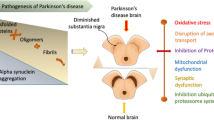Abstract
The compound 1-methyl-4-phenyl-1,2,3,6-tetrahydropyridine (MPTP) induces an irreversible neurological syndrome in man1,2 and monkey3 which is similar to idiopathic Parkinson's disease in its clinical, pathological, neurochemical and pharmacological response properties. MPTP is selectively neurotoxic to the dopaminergic regions of the brain, destroying neurones in the substantia nigra (A8 and A9 cells, nigrostriatal system) but not the ventral tegmental area (A10 cells, mesolimbic system)3. Selective dopamine depletion and nigral cell loss after MPTP treatment has also been reported recently in the mouse4. The mechanism by which a peripherally administered, low-molecular weight compound exerts permanent but selective toxic effects on dopamine systems in the brain may be relevant to parkinsonian syndromes induced by other toxins and to the disease process in idiopathic Parkinson's disease. We report here that MPTP is oxidized in the brain to a pyridinium species (a compound with potent herbicidal activity) and, in the monkey, is trapped intraneuronally. Furthermore, we demonstrate that this enzymatic oxidation is blocked in vivo in the mouse by a monoamine oxidase inhibitor, a condition which also blocks the neurotoxicity5, indicating that the oxidative metabolism of MPTP is required for its neurotoxic effect.
Similar content being viewed by others
References
Davis, G. C. et al. Psychiat. Res. 1, 249–254 (1979).
Langston, J. W., Ballard, P., Tetrud, J. W. & Irwin, I. Science 219, 979–980 (1983).
Burns, R. S. et al. Proc. natn. Acad. Sci. U.S.A. 80, 4546–4550 (1983).
Heikkila, R. E., Hess, A. & Duvoisin, R. C. Science 224, 1451–1453 (1984).
Heikkila, R. E., Manzino, L., Cabbat, F. S. & Duvoisin, R. C. Nature 311, 467–469 (1984).
Lyle, R. E., Nelson, D. A. & Anderson, P. S. Tetrahedron Lett. 553–557 (1962).
Ward, D. P. et al. Drug Metab. Disposit. 10, 690–695 (1982).
Bodor, N., Farag, H. H. & Brewster, M. E. III Science 214, 1370–1372 (1981).
Jacobowitz, D. M., Burns, R. S., Chiueh, C. C. & Kopin, I. J. Psychopharmac. Bull. 20, 416–422 (1984).
Swartzbek, R. A. Proc. 12th Br. Weed Control Conf. Vol. 2, 851–856 (1974).
Cohen, G. Neurotoxicology 5, 77–82 (1984).
Birkmeyer, W., Knoll, J., Riederer, P. & Youdim, M. B. H. Mod. Probl. Pharmacopsychiat. 19, 170–176 (1983).
Author information
Authors and Affiliations
Rights and permissions
About this article
Cite this article
Markey, S., Johannessen, J., Chiueh, C. et al. Intraneuronal generation of a pyridinium metabolite may cause drug-induced parkinsonism. Nature 311, 464–467 (1984). https://doi.org/10.1038/311464a0
Received:
Accepted:
Issue Date:
DOI: https://doi.org/10.1038/311464a0
- Springer Nature Limited
This article is cited by
-
Quantitative Methods for Metabolite Analysis in Metabolic Engineering
Biotechnology and Bioprocess Engineering (2023)
-
Current understandings and perspectives of petroleum hydrocarbons in Alzheimer’s disease and Parkinson’s disease: a global concern
Environmental Science and Pollution Research (2022)
-
Chronic MPTP in Mice Damage-specific Neuronal Phenotypes within Dorsal Laminae of the Spinal Cord
Neurotoxicity Research (2021)
-
Motor Neurons Pathology After Chronic Exposure to MPTP in Mice
Neurotoxicity Research (2020)
-
MPTP Mouse Model of Preclinical and Clinical Parkinson’s Disease as an Instrument for Translational Medicine
Molecular Neurobiology (2018)





